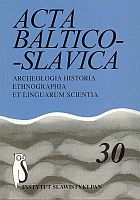Baltų ir kalbų rytinės sienos raida
The Development of the Eastern Border of the Baltic and Slavonic Languages
Author(s): Kazimieras GaršvaSubject(s): Language and Literature Studies
Published by: Instytut Slawistyki Polskiej Akademii Nauk
Keywords: borders of the Baltic and Slavonic languages; hydronyms; oikonyms; Surnames; substrate of the Baltic languages
Summary/Abstract: The studies of place names show that the north of Belarus can be divided into the following areas: 1. from the present border of the Republic of Lithuania to the line Pliusy, Zaracha, Delek, and Kazeny, where 90% to 60% of oikonyms of Lithuanian origin can be found; 2. up to Druja, Miory, New Pogosts, and Jody districts inclusive (60%-20% of Lithuanian oikonyms); 3. up to Verchnedvinsk, Germanovich, and Glubok districts (5%-1% of Lithuanian oikonyms); 4. up to Obole, Ula, Obolcy, Tolochin, where Lithuanian oikonyms, hydronyms and antroponyms are found; 5. up to Smolensk district in Russia. In the above mentioned areas even in the parts of the same district the number of Lithuanian and Baltic place names is unequal. The bigger concentration of Lithuanian place names shows that more Lithuanians lived there and they lived there for a longer time (districts of Ikazne-Jody, Perebrode, Druja and others). The place name kumsa “Kamša” in the parish of Ikazne and the harder consonants enable us to draw a conclusion that people there spoke in the same dialect of Vilniškiai up to now spoken 10-20 kilometers to the west and north-west. Braslav-Opsa region where there are found balú.ndiške “Balandišk˙e”, kumpi.nei “Kampiniai”, šalakú.ndzei “Šalakandžiai”, etc. There you can find the unquestionable examples of consonant hardening: dvarchany “Dvarcionys”, parshali “Paršeliai”, etc. People used the Dz—ukai dialect not only before the a-type vowels (Gaucy, Gedze, Giraucy, Girnuci, Labucy) but also in some places before the i-type vowels (Bardzilava, Grodzishki). The Byelorussian and Polish languages could stimulate the keeping of the Dz—ukai dialect, and the Russian language — keeping of c and dž (Driguchi, etc.). In the environs of Aina-Radashkovichy, the family names with the ending -is were known not only in the 16th century (Shikucis) but in the 19th and 20th centuries as well (Meszkis, Szedzianis). So we can suppose that the remains of the Lithuanian language were found there at least up to the 19th century. People spoke the Vilniškiai dialect (skrundz “skrandis”, Shikucis “šikutis”), and the consonants were made harder irregularly (Szareiko “Šereika”, but Szedzianis “Šedenis”, Viazewicz “V˙eževicius”).
Journal: Acta Baltico Slavica
- Issue Year: 2006
- Issue No: 30
- Page Range: 283-290
- Page Count: 8
- Language: Lithuanian

